The title of this article may conjure up some doubt in one’s mind, or it may elicit a comment at the kitchen table of, “No way 10 seconds of water can put out a fire!” The information I will present here comes from years of observation from practical fireground experience and teaching fire service classes. I have given people a hard time for not being able to manage a hoseline effectively and efficiently, and I have received banter from members for not being able to handle a hoseline. I have also tried many ways to improve my and my company’s hoseline management when advancing on a fire. Through some recent education-based on classroom and field experience-and a few trials with various career and volunteer personnel, I present here the “10-Second Flow Method” for advancing on a fire. (Note that I did not say “extinguish”; I said “advance.”)
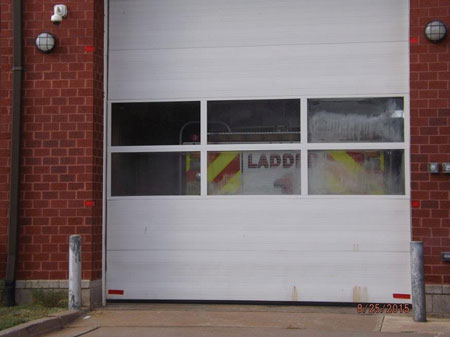 |
| (1) The red marks on the brick indicate the 10-foot, four-foot, and floor levels of a room. (Photos by author.) |
The Team
Some members are better nozzle firefighters, some are better operators, and some are better backup firefighters. So, the first step is knowing your team and each team member’s capabilities. Then, put the right people in the right spots. Next, ensure that your personnel understand their roles and responsibilities on the team. When I describe this to people, I use the analogy of a track team, a wrestling team, or a gymnastics team; for the team to be successful (win), you must understand your individual role on the team (winning the event). I tend to rely on semantics when giving descriptions; everyone must understand that personnel can know their role by simply being told what it is or training in the classroom. However, personnel understand their role when they practice it repeatedly.
 |
| (2) Personnel apply water with a fog nozzle set to a narrow fog for 10 seconds and move the nozzle in a smooth, controlled motion. This is being pumped through a 200-foot, 1½-inch attack line with a 125-gpm, 75-psi fog nozzle. |
The Flow and the Stream
I will not delve into the debate on smooth bore and fog nozzles; the beauty of this method is that you can apply it with either stream. The thing to remember is the amount of time that we apply the stream. I took a long, hard look at nozzle reaction when it came to applying water. The work of Danbury (CT) Fire Department Captain David P. Fornell and the London Fire Brigade’s Paul Grimwood determined that if personnel are fighting the nozzle reaction, then they are not concentrating on fighting the fire. In my career department, we use 125-gallon-per-minute (gpm) fog nozzles on 1½-inch attack lines, and we have put out quite a number of fires containing modern fuel loads. That said, I posed the question to my personnel, “What is the minimum fire flow needed to advance on a fire where we have decided to make an interior attack?” The answers varied, but we all agreed that it was 125 gpm. I then posed the question, “Why do we need to flow 186 gpm at 50 pounds-per-square-inch (psi) nozzle pressure for a smooth bore to advance on the same fire?”
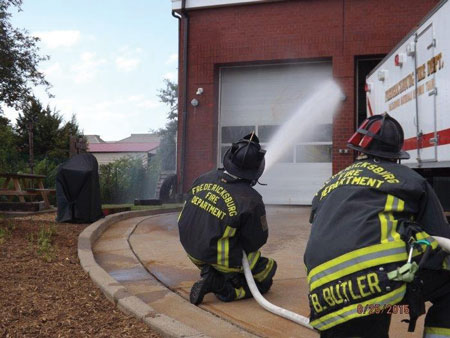 |
| (3) Personnel apply water with a fog nozzle set to a narrow fog for 10 seconds and move the nozzle in a smooth, controlled motion. This is being pumped through a 200-foot, 1½-inch attack line with a 125-gpm, 75-psi fog nozzle. |
At this point, we started discussing nozzle reaction and adjusting our nozzle pressures for smooth bore flows. A few years ago at the Andy Fredericks Training Days in Alexandria, Virginia, a presenter mentioned that some fire departments were adjusting their smooth bore nozzle calculations for 40-psi nozzle pressure because personnel were having difficulty advancing the line to the fire. The recommended nozzle reaction for a one-person line is 60 pounds, 75 pounds for a two-person line, and 95 pounds for a three-person line. At 50-psi nozzle pressure from a 15⁄16-inch tip on a 1½-inch attack line (185 gpm), the nozzle reaction is 73 pounds; at 40-psi nozzle pressure from the same line (165 gpm), the nozzle reaction is 58 pounds; and at 30 psi from the same line (143 gpm), the nozzle reaction is 44 pounds. Although it was easier to kink the line at 30-psi nozzle pressure, you must still make an effort to kink the line.
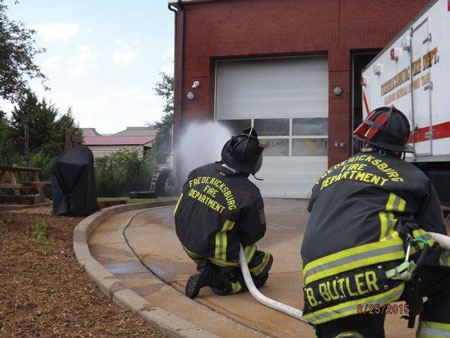 |
| (4) Personnel apply water with a fog nozzle set to a narrow fog for 10 seconds and move the nozzle in a smooth, controlled motion. This is being pumped through a 200-foot, 1½-inch attack line with a 125-gpm, 75-psi fog nozzle. |
After adjusting our pressures, all personnel stated that it was much easier to manage the nozzle and flow water when the nozzle pressure was reduced to 40 psi and 30 psi. Why were they able to do their job more efficiently? Because they were not fighting the force of the nozzle coming back at them. If you are on a company that is minimally staffed or understaffed (minimum staffing for my engine is three-the driver, the firefighter, and the officer), then I encourage you to adjust your pump pressures based on nozzle reaction while still maintaining an adequate fire flow. This will allow your nozzle firefighter to work more efficiently and also allow the officer to perform his supervisory duties and maintain accountability.
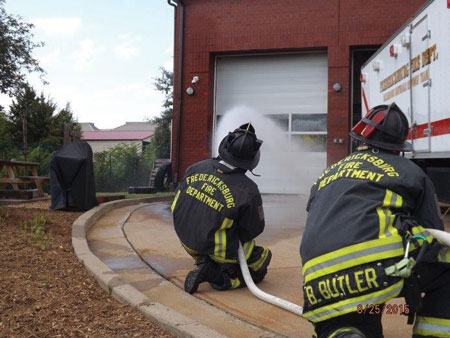 |
| (6) Personnel apply water with a fog nozzle set to a narrow fog for 10 seconds and move the nozzle in a smooth, controlled motion. This is being pumped through a 200-foot, 1½-inch attack line with a 125-gpm, 75-psi fog nozzle. |
The Application
Seattle (WA) Fire Department Firefighter Aaron Fields describes-with a musical analogy-two ways of applying water: You can do it more like Metallica or more like Marvin Gaye. The “10 Seconds of Water” application builds on this, and the nozzle firefighter and officer have to have a tangible number in their heads on which to build. It forces the team to operate the stream in a smooth, controlled manner, and if the officer counts to 10 along with them, he can size up the actions of his personnel and give a report back to command.
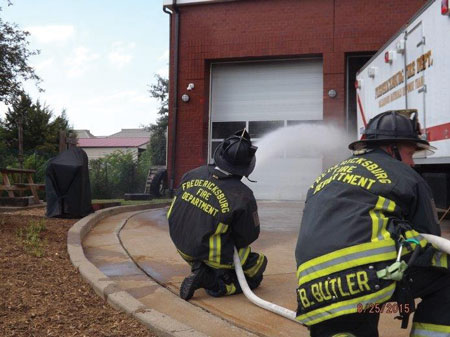 |
| (5) Personnel apply water with a fog nozzle set to a narrow fog for 10 seconds and move the nozzle in a smooth, controlled motion. This is being pumped through a 200-foot, 1½-inch attack line with a 125-gpm, 75-psi fog nozzle. |
Step 1. Starting in the upper corner of the room (left or right, it doesn’t matter), corridor or entryway, begin operating the line. Begin counting, and slowly move the line to the other upper corner. This should take about two to three seconds.
Step 2. From that upper corner, bring the line down in a diagonal move to about the four-foot level and make two passes horizontally at that four-foot level while continuing your count; do not start the count over. This should take four to five seconds (total elapsed time: six to eight seconds), and you should end at the same side you started.
Step 3. Move the line back across the floor horizontally. This should take about two to four seconds (total elapsed time: 10 seconds).
Step 4. The officer will assess the surroundings, and if he determines to continue flowing the line, repeat steps 1, 2, and 3 while maintaining that 10-second count. If the officer determines that the hose team should advance on the fire and doing so isn’t practical while still flowing water (remember the team), shut down the line until the officer decides to flow water again. When he determines to flow water again, begin with the 10-second count.
The rationale. Applying water in this manner satisfies a lot of the teachings out there. We know that we can extinguish fire through gas cooling and door control. We have also learned that the heat release rate (HRR) of materials in our modern fire environment is allowing fires to grow faster with higher temperatures. That being said, we can slow down the HRR by cooling the surface.
The best way to accomplish gas cooling is with low-flow lines and high pressures. Surface cooling is best achieved through high-flow lines and low pressures. So, the majority of the American fire service is operating under the mindset of high flows and low pressures.
 |
| (7) The water is applied in the same manner, only this time personnel use a 15⁄16-inch smooth bore nozzle pumping at 40-psi nozzle pressure. Pumping the line at this nozzle pressure gave us a flow of approximately 165 gpm. |
The beauty of “10 Seconds of Water” is that it achieves gas cooling while focusing on cooling the materials that are releasing the gases. This is why it is important to have two passes at the four-foot level. We give ample time to cool the surfaces that are releasing the gases that allow the fire to rapidly grow.
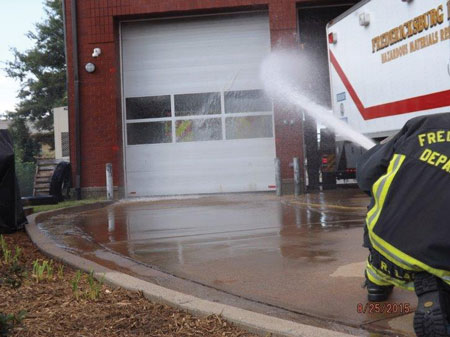 |
| (8) The water is applied in the same manner, only this time personnel use a 15⁄16-inch smooth bore nozzle pumping at 40-psi nozzle pressure. Pumping the line at this nozzle pressure gave us a flow of approximately 165 gpm. |
There are discussions in the fire service that flows of 125 gpm, 150 gpm, and 185 gpm are not needed to extinguish the fires and that many of them can be put out with 30 or 95 gpm through the application of door control and gas cooling. The rationale for this, which I have given my personnel, is that although we can extinguish a fire in one minute with 30 gallons of water, I can achieve the same thing in one-sixth of the time. If I flow water for 10 seconds using the aforementioned flows and the fire goes out, then I have only flowed 22 gallons, 25 gallons, and 31 gallons, respectively. Therefore, I am actually decreasing the amount of time personnel are in the immediately dangerous to life or health area, and they are still applying just as much water.
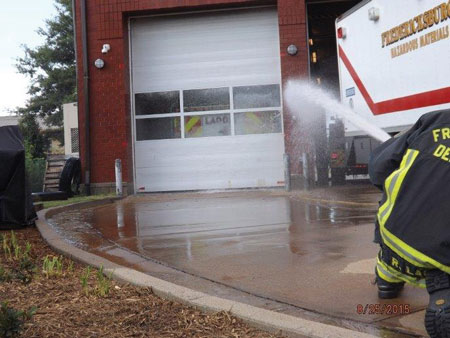 |
| (9) The water is applied in the same manner, only this time personnel use a 15⁄16-inch smooth bore nozzle pumping at 40-psi nozzle pressure. Pumping the line at this nozzle pressure gave us a flow of approximately 165 gpm. |
This is another tool in the fire service’s proverbial “toolbox.” Do not rush to judge the ineffectiveness of this tactic until you have tried it. As you work more with your team, you will find better ways to apply water. This tactic may be best suited for fire academies, where people are just being introduced to the use of hoselines and the application of water. Further, sometimes companies have to start over after transfers and promotions take place, and we need to ensure that the team has the foundation to be successful. The “10 Seconds of Water” application gives us something tangible to teach and evaluate. And, the next time the nozzle firefighter gets beat up by the nozzle because of its erratic movement, you can ask him, “Did you count to 10?”
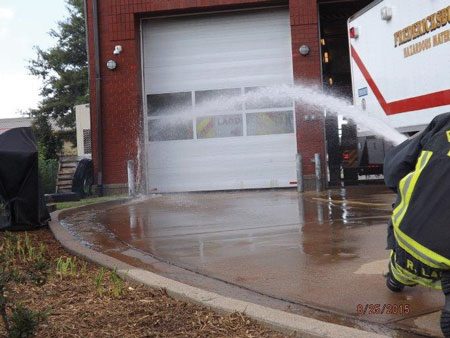 |
| (10) The water is applied in the same manner, only this time personnel use a 15⁄16-inch smooth bore nozzle pumping at 40-psi nozzle pressure. Pumping the line at this nozzle pressure gave us a flow of approximately 165 gpm. |
I have attended recent trainings where a thermal imaging camera was used to keep an eye on the surroundings. There are certain parameters used to assess fire conditions and determine if the situation is a “go” or “no-go.” If the situation is a “no-go,” it does not mean that we write off the building and stay outside; it means we apply the water to the environment to create a “go” situation. If the temperature threshold is reached while advancing down a corridor, we stop and apply water to the environment. But how long do we apply the water? Again, the answer is no less than 10 seconds.
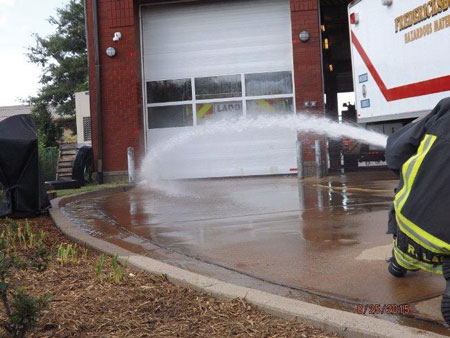 |
| (11) The water is applied in the same manner, only this time personnel use a 15⁄16-inch smooth bore nozzle pumping at 40-psi nozzle pressure. Pumping the line at this nozzle pressure gave us a flow of approximately 165 gpm. |
Go out and train with your engine company. If your personnel are operating the line erratically and are having a hard time controlling it, implement the 10-second count until it becomes second nature. Also teach it when you teach a fire streams class in an academy or company training session. Andy Fredericks stated, “A disciplined engine company is deliberate, patient, and professional.” The 10-second count invokes all three of these disciplined engine company aspects. Remember, continue to apply the water until the fire is out or conditions are tenable to advance.
 |
| (12) There was approximately 76 feet of reach of the fire stream. This was measured from the position of the nozzle firefighter. Note the large swath that the fire stream covers. This is indicative of the surface that needs cooling while crews advance on a fire. |
References
Fornell, D. Fire Stream Management Handbook. Fire Engineering Books (May 1991).
Grimwood, P. Fog Attack, Firefighting Strategy & Tactics: An International View. FMJ International (1992).
JACK McGOVERN is a 23-year veteran of the fire service and a lieutenant with the Fredericksburg (VA) Fire Department (FFD) assigned to Engine 2’s A-Shift. He is also an FFD Dive/Water Rescue Team leader and a National Incident Management System compliance officer. McGovern is also an active life member with the Occoquan-Woodbridge-Lorton Volunteer Fire Department in Woodbridge, Virginia. He instructs on a number of fire service topics throughout Virginia and is the lead instructor for ARFF, Mass Casualty, and Haz-Mat programs at Ogle Airport in Guyana, South America. He is a fire instructor level II and fire officer IV and has a BS degree in criminal justice from Old Dominion University.
Little Drops of Water: 50 Years Later, Part 1
Little Drops of Water: 50 Years Later, Part 2
Water Management Officer: Taking Charge of the Water
Fire Engineering Archives

